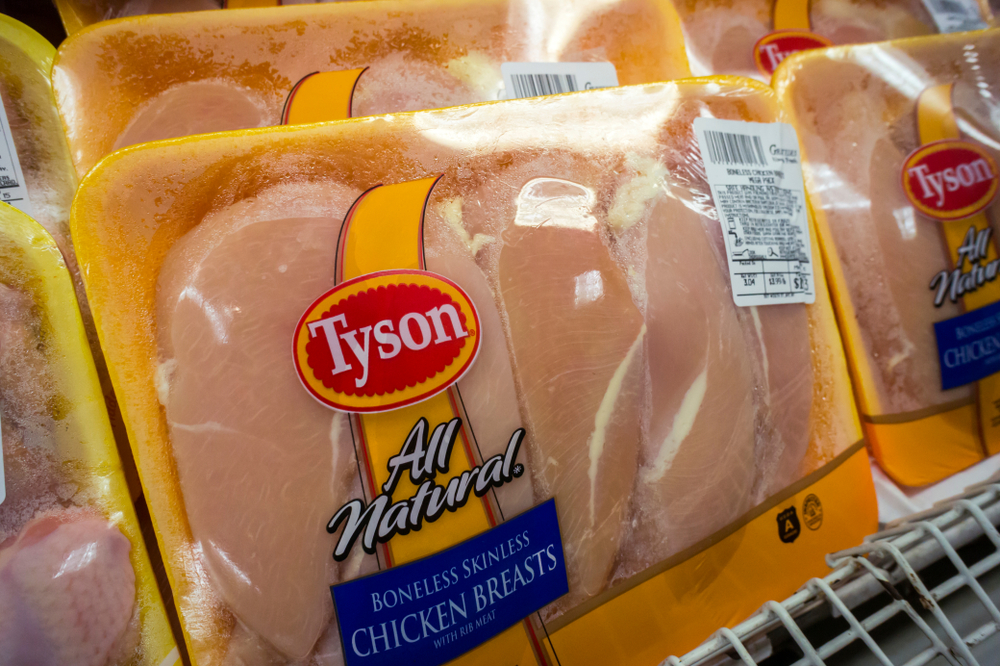Over the last 16 years, many Americans have unknowingly overpaid billions for chicken, according to a trending antitrust lawsuit. Think about every chicken breast, wing, or whole bird you purchased from the grocery store between 2009 and 2020.
That seemingly innocent package of raw chicken most likely carried an invisible surcharge – not from regular market forces, but from a calculated conspiracy among the nation's largest poultry producers.
The broiler chicken antitrust litigation alleges how household names like Tyson Foods and Pilgrim's Pride orchestrated a massive scheme that touched nearly every American dinner table.
A $203.35 million broiler chicken settlement fund is now available for any consumer who purchased fresh or frozen raw chicken during the class period.
How Big Chicken Allegedly Fixed Prices
Before 2008, the broiler chicken market followed predictable boom-bust cycles. When prices rose, producers increased production. When oversupply drove prices down, producers cut back. This natural rhythm kept the market relatively balanced.
Traditional competition abandoned
According to the courts, everything changed in 2009 when major chicken producers abandoned traditional patterns, instead of competing, and began coordinating.
Evidence showed the industry developed a new vocabulary – "capacity discipline," which became its euphemism for supply manipulation.
Private meetings and collaboration
Through secret conferences at trade associations and information sharing, competitors transformed into conspirators.
The supposedly independent data service (AgriStats) played a particular role in this meat industry antitrust settlement.
Independent agency compromised
The courts have found that AgriStats collected detailed production information from chicken processors and redistributed it in ways that allowed competitors to identify each other's operations.
While the data appeared anonymous, industry insiders could easily determine which facilities belonged to which companies.
Market Manipulation In the Poultry Industry
The antitrust conspiracy allegedly operated through multiple coordinated strategies:
- Production cuts across the industry – Starting in 2008, major producers simultaneously reduced output.
- Strategic plant closures – Companies shuttered processing facilities, eliminating thousands of jobs.
- Breeder flock destruction – Producers killed breeding chickens early, limiting future supply for years.
- Export manipulation – Companies shipped hatching eggs overseas to reduce the domestic supply.
The coordinated effort to reduce the supply of broiler chickens succeeded beyond expectations. By 2014, chicken prices had increased nearly 50% from 2008 levels despite falling feed costs.
Understanding Antitrust Violations
The Sherman Act, passed in 1890, prohibits conspiracies that restrain trade.
Sherman Act explained
Federal antitrust law makes price-fixing among competitors a serious crime. The broiler chicken producers violated Section 1 through their agreement to limit supply and inflate chicken prices.
Key elements of the Sherman Act violation:
- Agreement between competitors
- Restraint of trade
- Effect on interstate commerce
- Consumer harm through higher prices
State Antitrust Laws
State antitrust laws provide additional protections beyond federal statutes. The 25 states included in this settlement have laws allowing indirect purchasers to recover damages.
- Some states explicitly allow consumer class actions
- Others provide statutory damages beyond actual harm
- Many permit attorney fee awards to successful plaintiffs
The interplay between state and federal law explains why the settlement covers specific states.

Chicken Producers Named in the Lawsuit
The chicken class action lawsuit settlement involves some of the biggest names in American poultry.
Tyson Foods
Tyson Foods leads the pack with a $99 million contribution to the settlement fund. As the nation's largest meat processor, Tyson's participation in the alleged conspiracy had far-reaching effects on grocery prices nationwide.
Pilgrim's Pride
According to the people who sued, Pilgrim's Pride, the second-largest contributor at $75.5 million, played a central role in orchestrating production cuts. Company executives allegedly made public calls for "industry discipline" while privately coordinating with competitors to limit supply.
Other defendants
Other significant contributors to the 181 million class action settlement include:
- Sanderson Farms
- Perdue Farms
- Koch Foods
- Wayne Farms
- Mountaire Farms
- Peco Foods
- Foster Farms
Each company's settlement amount reflects its market share and role in the conspiracy. Together, these defendants controlled approximately 90% of the wholesale broiler chicken market during the conspiracy period.
Recent Additions to the Settlement
March 2025 brought significant expansion to the chicken settlement payout pool.
Additional chicken producers agreed to contribute $22.5 million, bringing the total settlement fund to $203.35 million.
The new settling defendants include:
- Claxton Poultry
- Harrison Poultry ($2.9 million)
- House of Raeford ($4.5 million)
- Koch Foods ($5 million)
- Mountaire ($3 million)
- O.K. Foods ($3.2 million)
- Sanderson Farms ($750,000)
- Simmons ($3 million)
Who Can File a Claim
The settlement class includes consumers from 25 states plus the District of Columbia.
Your eligibility depends on where you purchased fresh or frozen raw chicken, not where you currently live.
Geographic Requirements
The covered states include:
- California, Florida, Hawaii, Illinois, Iowa
- Kansas, Maine, Massachusetts, Michigan, Minnesota
- Missouri, Nebraska, Nevada, New Hampshire, New Mexico
- New York, North Carolina, Oregon, Rhode Island, South Carolina
- South Dakota, Tennessee, Utah, Wisconsin, District of Columbia
These states have specific antitrust laws that provide additional consumer protections beyond federal law. You qualify for compensation if you purchased any chicken product in these jurisdictions.
Purchase Requirements
Understanding what purchases qualify helps determine your eligibility:
Covered chicken products
- Whole fresh or frozen chickens (with or without giblets)
- Cut-up chicken sold in packages
- Chicken breasts and tenderloins
- Wings and drumsticks
- Any raw chicken parts
Purchase timeframes vary by defendant
- Original settlement defendants: January 1, 2009, through December 31, 2020
- Extended settlement defendants: January 1, 2012, through July 31, 2019
Excluded products:
- Organic chicken
- Kosher chicken
- Halal chicken
- Free-range chicken
- Pre-seasoned or breaded chicken
- Rotisserie or other cooked chicken
The exclusions exist because these specialty markets operate differently from the conventional broiler chicken market that the defendants manipulated.
Compensation Structure: How Much You Could Receive
Using a pro rata system, the settlement administrator will divide the $203.35 million net settlement fund among all valid claimants.
Pro rata distribution explained
Your chicken settlement payout depends on several factors:
- Total number of valid claims filed
- Amount of chicken you purchased
- Dollar value of your purchases
- Available funds after administrative costs
No proof of purchase requirement makes participation easier. You only need to estimate your purchases based on your household's typical consumption patterns. A family of four buying chicken weekly could have spent thousands of dollars during the class period.
FOR EXAMPLE: If 500,000 consumers file valid claims and the net fund contains $150 million, the average payment would be $300. However, actual disbursements will vary based on individual purchase amounts.
Settlement Fund Breakdown
Understanding how the $203.35 million settlement fund gets distributed helps set realistic expectations:
- Attorney fees: Up to $67.7 million (approximately 33%)
- Litigation costs: Up to $9.75 million
- Settlement administration: Costs to process claims and distribute payments
- Service awards: Up to $2,000 each for class representatives
- Net to consumers: Remaining funds distributed pro rata
Even after these deductions, the settlement provides meaningful compensation to affected consumers.
How To File Your Claim
Filing your settlement claim online offers the fastest, most convenient option.
Online method
The settlement website provides a user-friendly interface that guides you through each step:
- Visit OverchargedForChicken.com
- Click the "File a Claim" button
- Enter your contact information
- Estimate your chicken purchases by year
- Submit your claim electronically
- Save your confirmation number
The online system calculates your estimated purchases based on household size and shopping frequency.
You don't need receipts or other documentation unless specifically requested during the review process.
Alternative Filing Methods
Some consumers may prefer traditional mail to file their claim. You can download a PDF claim form from the settlement website and mail it to:
Broiler Chicken Consumer Litigation
c/o A.B. Data, Ltd.
P.O. Box 173045
Milwaukee, WI 53217
Tips for a successful submission
- Complete all required fields
- Write legibly if filing by mail
- Keep a copy for your records
- Submit before the deadline
- Update your address if you move
If you previously filed a claim in earlier settlements, you automatically receive payment from new settlements without resubmitting.
Lasting Impacts and Corporate Accountability
This historic settlement represents more than monetary compensation. American families most likely paid a hidden tax on one of their most basic protein sources for over a decade. Class plaintiffs say the conspiracy affected birthday barbecues, holiday dinners, and weeknight meals for millions of households.
The broiler chicken price-fixing settlement also demonstrates how market concentration can enable abuse. When a handful of companies control most production, the temptation to coordinate rather than compete grows strong.
This settlement compensates for such harm and strives for a more competitive future in America's grocery aisles.
Frequently Asked Questions (FAQ)
No proof of purchase is required for the broiler chicken class action settlement. You simply estimate your household's chicken purchases during the covered period based on your typical shopping habits. The settlement administrator created an accessible claims process, recognizing that most consumers haven't kept their grocery receipts.
The 25 states covered in this antitrust settlement have specific laws allowing indirect purchasers (consumers) to recover damages from price-fixing conspiracies. Federal antitrust law typically only permits direct purchasers to sue, but these states provide additional consumer protections through their own antitrust statutes.
The broiler chicken processors coordinated to reduce supply through plant closures, limiting production, destroying breeder flocks, and sharing competitive information through Agri Stats. This "capacity discipline" artificially restricted chicken availability, driving up prices approximately 50% despite falling feed costs during the conspiracy period.
The original $181 million settlement covers chicken purchases from January 2009 through December 2020, while the new $22.5 million settlement covers January 2012 through July 2019. If you filed a claim in the original settlement, you're automatically included in the new settlements without needing to file again.



Add Comment